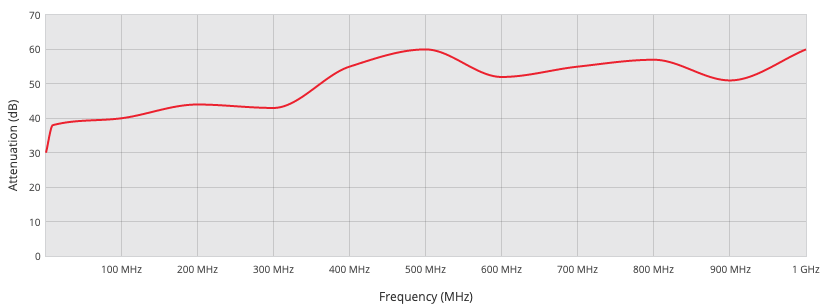EMI/RFI shielding of plastic enclosures/housings can be done by using an electrically conductive paint containing nickel, copper or silver.
Application of our electrically-conductive nickel coating 3800 series is a fast and easy method for EMI/RFI shielding/screening of plastic enclosures/housings. Your electrostatically sensitive applications can be shielded by using this electrically conductive paint which contains nickel, copper or silver.
The paint comes in aerosols (Part number 3801) for easy use and packaged in tins of 5 liters, 7 kg (Part number 3805) and tins of 20 liters, 28 kg (Part number 3820). Please contact us if you need special package requirement. Materials such as iron-chromium-aluminum and molybdenum disilicide are used for higher temperature applications.
Some oxide ceramics are used as conductors and semi-conductors for specialized applications. To fulfill the requirements concerning the limits of immunity and emission to interference, plastic housings and components need to be coated either fully or selectively with an electrically conductive coating. The nickel-conductive coating is contained in an air-drying acrylic resin.
The resin dries to touch in 15 minutes after application and can achieve maximum conductivity within 24 hours. It is intended to prevent electrical interference which penetrates enclosures made from thermoplastics and other insulating materials. The coating also prevents static build up.
It is recommended that a grounding connection is made to achieve maximum shielding performance. A suitable material for this is Part number 3201, Copper shielding tape which can simply be stuck onto the coated surface or over-sprayed with the electrically-conductive nickel coating. The coating once applied has a mat gray textured finish.
Benefits:



Physical properties
| Colour | grey |
| Flash point (Abel closed cup – method IP 33/59) | 25 °C |
| Recommended dry film thickness (ASTM D 4138-82) | 50 microns (2 thou) |
| Specific gravity | 1.5 g/cc |
| Coverage per litre at 50 microns | 7-10 square metres |
| Drying time: touch | 15 minutes |
| Drying time: full | 12 hours |
| Adhesion (BS 3900 E6) | Excellent |
| Pencil hardness (ASTM D3363-74) | H |
| Shelf life | 12 months |
| Surface resistivity at 50 microns (2 thou) ASTM D257 | 0.5 Ohms/square or less |
| Viscosity when thinned 1:1 with *** thinners | 0.6 p on a cone & plate, 27-32 secs on a B4 flow cup |
| Shielding effectiveness (dB) | 50-55 |
Availability:
Shielding effectiveness
3800 series – Conductive nickel coating

| ■ 3800 Conductive nickel coating |
Please note: These values are measured under laboratory conditions and may differ in other environment. Please read our Guarantee.
Method of use:
Surface preparation: All contaminants including mould release, grease and dirt must be removed. Mask areas that do not require coating. A suitable primer may be necessary on certain substrates such as Polyethylene and Polypropylene, etc.
Mixing and application: Care must be taken to ensure the concentrate is thoroughly mixed to ensure that all the solids are in suspension.
Electrically-conductive nickel coating may settle out and regular agitation is recommended during spray application. The paint should be diluted with thinner *** to suit local spray conditions. Typically 2 parts of concentrate to 1 part thinner can be used in a conventional gravity-feed spray gun or, alternatively, a pressure pot with agitator. Gun pressure of 30 psi is recommended. Two passes are normally required to achieve optimum thickness and surface resistivity values.
Brush coating: Brush coat from the can, or thinned to suit the application.
For easy application of the electrically-conductive nickel coating, we have a small sprayer which is to be connected to a compressor.
The 3801 is in a pressurized container and must be protected from sunlight. Do not expose to temperatures exceeding 50°C and do not pierce or burn after use. Do not spray on an open flame or any incandescent material. Keep away from sources of ignition – No Smoking (S16)
Use Under Well Ventilated Conditions: Contains Nickel, Ethyl Acetate, Xylene, Butyl Ethanoate, Isobutanol. – Do not breath vapor (S23). Harmful by inhalation (R20). In case of insufficient ventilation – please wear suitable respiratory equipment (S38) and such equipment must be used in accordance with the manufacturer’s instructions. In case of excessive vapor inhalation, move to fresh air environment immediately and summon medical attention.
Avoid Contact With Skin And Eyes (S24/25) – In case of skin contact, wash with soap and water, dry and apply work cream. Eye contact – flush with water for at least 15 minutes and seek medical attention. If accidentally swallowed, summon medical attention.
For easy application of electrically conductive nickel coating, we can offer a small sprayer that needs to be connected to a compressor.
There are no free samples for this product.
Get a Quotation
Fill in the form below